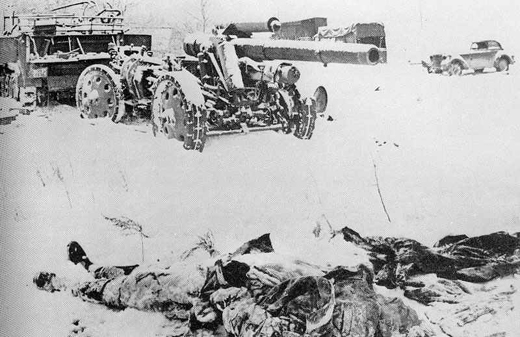Air Operations - Europe
BOMBER COMMANDA total of 154 aircraft, including 89 Wellingtons, are sent to hit targets in the Brest area. 87 aircraft are given the Gneisenau and the Scharnhorst as their targets while the rest are to hit the naval yards. Accurate bombing is prevented by a smoke screen but large fires are seen after the attack. No aircraft are lost.
In minor operations, 37 planes are sent to Cherbourg and 5 more lay mines in Quiberon Bay. There are no losses.
[Black Sea
The battleship Parizhskaya Kommuna bombards German positions on the Crimean coast.
[Eastern Front
Stalin refuses advice from Zhukov and his other military advisers and in an address to the Stavka, the GHQ of the Soviet High Command, orders offensives on all fronts rather than concentrating against Army Group Center. Zhukov has argued that Soviet resources are not sufficient to allow such diverse operations and that, although early successes may be achieved, there will be no reserve of strength to break into German fortified positions. This will turn out to be an accurate prediction.
In the northern sector fighting continues along the Volkhov River with no major gains by either side although the Russians recapture the Kirichi rail junction. At Leningrad, where cold and hunger claims hundreds of victims every day, preparations are made for a massive evacuation of the civilian population across frozen Lake Ladoga.
In the central sector, the Russians retake Belev, west of the Oka River. In the southern sector, Red Army reinforcements land on the coasts of the Crimea near Evpatoriya and Sudak to attempt to break the siege on the fortress of Sevastopol by the Germans and the Rumanians. The Russians make little progress, however, against the stubborn German resistance.
SOUTHERN SECTORThe Germans are counterattacking the 21st Army around Belgorod, prompting Timoshenko to commit the 38th Army in this area. In the Crimea, the Germans repel Red Army landings at Sudak and Evatoria.[MORE]
Left Behind by the Retreating Germans |
 |
Malaya
On the Slim River line the 11th Indian Division repels a Japanese attack along the Penang-Singapore railway line. Japanese reinforcements land on the west coast of the peninsula. British forces pull back to new defensive positions. The headquarters of the British Far East fleet is transferred from Singapore to Batavia, in Java.
[Malta
The bombing of the island by Axis forces is intensified.
[Mediterranean
- A large Italian convoy reaches Tripoli. The Italian submarine Ammiraglio St. Bon, carrying gasoline to North Africa, is sunk by the British submarine, Upholder.
- The British submarine Upholder sinks the Italian submarine Ammiraglio St Bon northwest of Messina. 3 crewmen are rescued.
- The British submarine Proteus sinks the Italian troopship Citta di Palermo 3 miles west of Cape Dukato in the Ionian Sea.
North Africa
The German defenses in the Halfaya Pass are assaulted by British forces.
An Axis convoy reaches Tripoli with 20 armored cars, a batch of anti-tank guns, a stock of fuel and 54 tanks with crews. The tanks are Mark IIIs strengthened with additional plate on the front of the hull.
[Occupied France
The dismembered body of Yves Paringaux, head of anti-terrorist activities at the Vichy Ministry of the Interior, is found on a railway line at Melun. The Vichy government blames Communists.
[Pacific
- The Japanese submarine I-56 sinks the British steamer Kwantung (2626t) south of Java, then rams and machine guns the lifeboats. 35 of 133 onboard are rescued the next day.
- The US submarine Pollock (SS-180) torpedoes and damages the Japanese cargo ship Heijo Maru 80 miles east-southeast of Tokyo Bay.
Philippines
Late in the day American forces begin to make withdrawals to a new defensive line at the base of the Bataan peninsula, from Dinalupihan on the west to Hermosa on the east. They have to fall back from this line also at the end of the day under violent Japanese pressure on the so-called 'Layac Line', where there is a bridge on which all roads leading to the Bataan peninsula converge. The bridge is blown up a little after midnight. Rations are cut in half for the defenders. The daily air offensive on Corregidor by the Japanese continues occasionally attacking other objectives in the Manila Bay area.
[Soviet Union, Strategy
Buoyed by the success of the Moscow counteroffensive, Stalin decides to expand the offensive to the whole front. Zhukov wants to maintain the focus against Army Group Center but is overruled. The Soviet dictator has failed to take into account the losses sustained by his forces during Moscow Offensive, which amount to 140,000 troops killed, and 429 tanks, 13,000 artillery pieces and 140 aircraft destroyed.
[